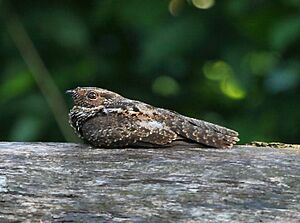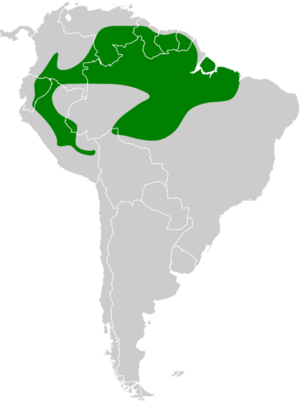Blackish nightjar facts for kids
Quick facts for kids Blackish nightjar |
|
|---|---|
 |
|
| at Apiacás, Mato Grosso state, Brazil | |
| Conservation status | |
| Scientific classification | |
| Genus: |
Nyctipolus
|
| Species: |
nigrescens
|
 |
|
| Synonyms | |
|
Caprimulgus nigrescens |
|
The blackish nightjar (Nyctipolus nigrescens) is a cool bird from the Caprimulgidae family. You can find it in many South American countries. These include Brazil, Bolivia, Colombia, Ecuador, French Guiana, Guyana, Peru, Suriname, and Venezuela.
Contents
About the Blackish Nightjar
Scientists first put the blackish nightjar in a group called Caprimulgus. But new studies of its DNA showed it was special. Now, it has its own group, or genus, called Nyctipolus. Its closest relative is the pygmy nightjar. The blackish nightjar is the only type of its kind, meaning it's "monotypic."
What Does It Look Like?
The blackish nightjar is about 19.5 to 21.5 cm (7.7 to 8.5 in) long. That's about the length of a large pencil. It weighs around 32 to 39 g (1.1 to 1.4 oz), which is lighter than a chocolate bar.
Its top feathers are dark brownish-black. They have cool spots of tawny, grayish-white, and cinnamon colors. Its tail is dark brown with faint lighter stripes. Male birds have a white tip on their tail.
The feathers on its belly are dark brown with lighter stripes. Its lower belly and sides are buffy (a pale yellowish-brown) with darker stripes. It has a small white patch on each side of its throat. When it flies, you can see a small white band on its wing.
Where Does It Live?
The blackish nightjar lives east of the Andes mountains. You can find it in Peru, Ecuador, and southern Colombia. It also lives across southern Colombia, through southern Venezuela, and into the Guianas. It reaches northeastern and north-central Brazil.
These birds love lowland evergreen forests. But they mostly hang out on or near open rocky areas. You might also spot them on sand and gravel banks along small rivers. They live at different heights, from sea level in Brazil to high up in the mountains. For example, they can be found up to 900 m (3,000 ft) in Bolivia.
How the Blackish Nightjar Behaves
What and When It Eats
The blackish nightjar is a night owl, or rather, a night bird! It is crepuscular, meaning it's active at dusk and dawn. It's also nocturnal, active at night. It hunts for food while flying. It flies over rocky areas and above the forest trees from sunset to sunrise.
Sometimes, it even walks on the ground to pick up food from large rocks. We don't know all the details of its diet. But we do know it eats moths and beetles. During the day, it rests on rocks or fallen trees.
How It Raises Its Young
The breeding season for the blackish nightjar changes depending on where it lives. But usually, it's during the long dry season. This is from August to November.
When a male wants to attract a female, he shows off his tail. He lifts it up to display the white markings. Females lay only one egg. They usually lay it in a small dip in bare rock. Sometimes, they lay it on bare sand or soil. They might nest alone or sometimes in small groups.
What Sounds It Makes
The blackish nightjar's song is short and soft. It sounds like a purring pu'r'r'r'r't or qu'r'r'r'rt. During their mating display, both the male and female sing. They also make a cluck or ptink sound if they are alarmed. If they feel threatened, they make a "guttural hissing" sound.
Status of the Blackish Nightjar
The IUCN (International Union for Conservation of Nature) checks on animals. They have said the blackish nightjar is of "Least Concern." This means it's not currently in danger of disappearing. We don't know exactly how many there are. But scientists believe their numbers are stable. They are quite common in places where they like to live.


